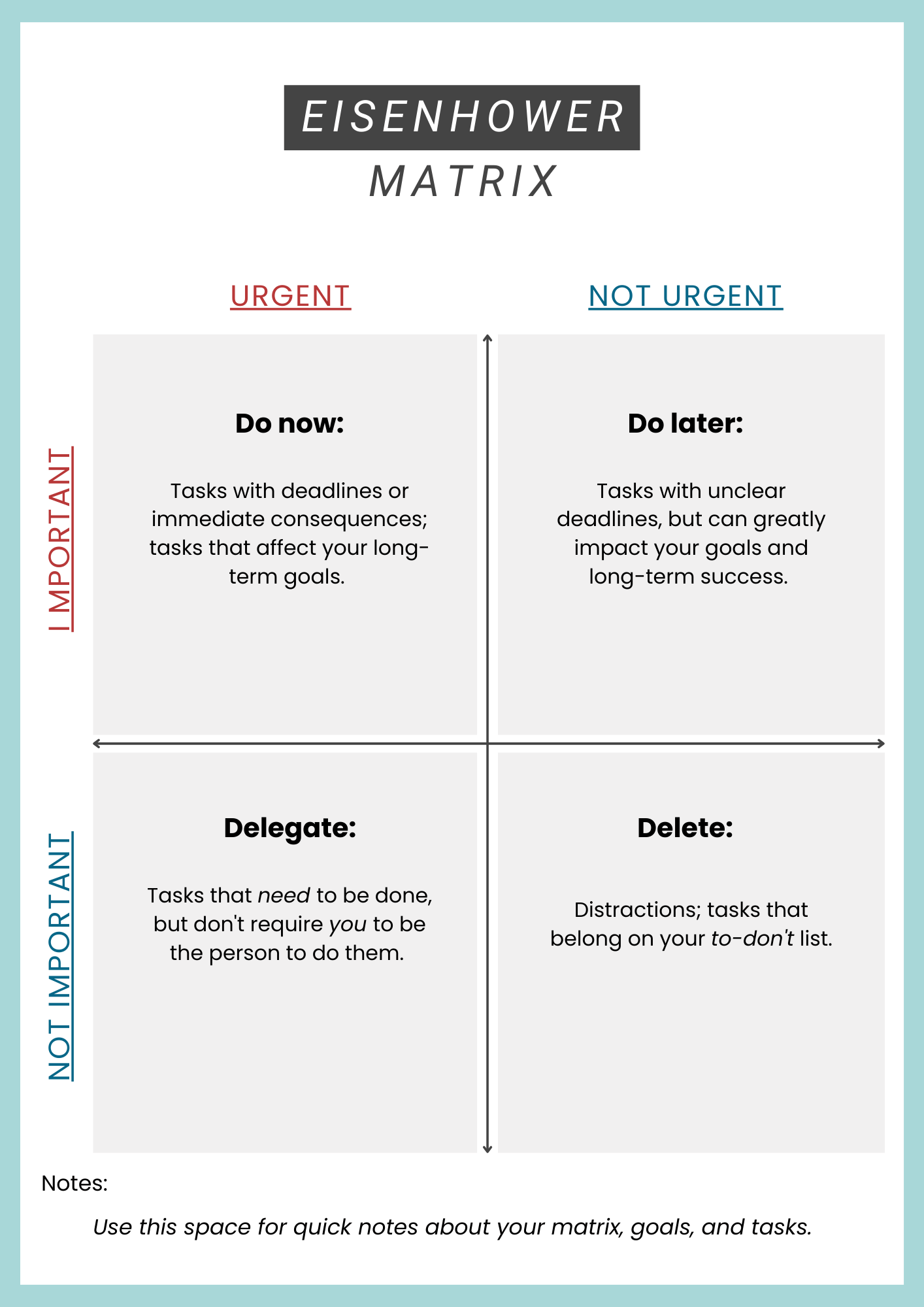Can I be honest with you? My ADHD makes it hard for me to get things done. (And no - I'm not making excuses.) The truth is, I really struggle when it comes to prioritizing tasks and getting myself organized enough to actually finish them. It's like a never-ending cycle of task paralysis, overwhelm, and putting things off until the very last minute.
Even with a good understanding of my ADHD struggles, it's easy to get stressed out by a long list of unfinished tasks and completely shut down.
While there's no magical solution to the challenges of task prioritization, one tool that's proven to be quite helpful—especially for those of us with ADHD—is the Eisenhower Matrix.
This ingenious creation by former United States president, Dwight D. Eisenhower, provides a framework for sorting tasks based on their urgency and importance, offering a practical approach to tackling them head-on.
Keep reading to learn how to apply this method to manage home life, adulting, and work tasks. You'll also find a template to help you get started!
Too long; didn't read
- The Eisenhower Matrix is a time management tool to help you prioritize and complete tasks.
- Tasks are divided into four quadrants: do now, do later, delegate, and delete.
- A priority matrix can help ADHDers overcome task paralysis and decision paralysis.
ADHD and executive dysfunction
People with ADHD often struggle with executive functioning skills, such as time management, focus, organization, planning, and self-censoring — to name a few.
Executive dysfunction is an impairment or difficulty in implementing these skills.
Executive dysfunction makes task prioritization difficult
In addition to complicating our ability to organize and plan, executive dysfunction can make it hard to know what tasks to prioritize and when to do them. As clinical psychologist Dr. Russell Barkley said, "ADHD is, at its heart, a blindness to time. Or, to be more accurate, nearsightedness to the future."
Struggling with executive function and task prioritization? The Inflow app has in-depth learning modules to help you break down your ADHD related struggles, stay on top of tasks, and keep your to-do list from getting out of hand. Get started with Inflow today!
The Eisenhower Matrix: Making time for the important stuff
The Eisenhower Matrix is a decision and task management tool created by the 34th U.S. President. Eisenhower originally created the matrix to help him (1) quickly determine the most important tasks that required his immediate attention and (2) prioritize them accordingly.
Want a free ADHD priority matrix template? Click here to view Inflow's template on Canva. Once there, you can download the template to your device.

How to use the Eisenhower Matrix
The Eisenhower Matrix separates tasks into four quadrants to help you see what you should do first, what needs to be done later, what should be given to someone else, and what can wait.
How to figure out what's "urgent" and "important"
Pay special attention to two keywords when using this tool: urgent and important.
Urgent tasks
Urgent tasks are those that demand your immediate attention. They often come with clear and swift consequences if not completed by a specific deadline.
Important tasks
Important tasks don't necessarily demand immediate attention; they likely do not have a deadline. However, they should still be prioritized in your priority matric since they need to be completed for you to reach your main goals.
Which tasks should be in each quadrant?
Top left quadrant: Do now!
Tasks in this quadrant (quadrant 1) are considered both urgent and important.
They need prompt action and are critical for reaching your goals. Therefore, these are the tasks you need to prioritize above all else.
Top right quadrant: Do later.
The tasks here (quadrant 2) are important but not urgent.
It's usually for tasks without deadlines (or those without immediate deadlines) that still contribute to long-term success.
You take care of these tasks later. Schedule an appropriate time for them and finish them only after you've handled the tasks from quadrant 1.
Bottom left quadrant: Delegate to others.
These tasks (quadrant 3) are urgent but not important.
They usually have an upcoming deadline but don’t necessarily require your skills or expertise. Therefore, tasks found here should be delegated to your team or household members.
Bottom right quadrant: Delete.
Once you've put tasks in the other three quadrants, you have a few remaining tasks that don't quite fit anywhere.
These tasks (quadrant 4) typically fall under the category of being not important and not urgent.
Because these tasks don’t actively help you reach your goals, you can label them as “distractions.” In that case, it’s best to eliminate them altogether. Alternatively, add these to your to-don't list as a reminder of what not to do during work or focus hours.
Practical tips for personalizing and optimizing your priority matrix
Creating and using an Eisenhower Matrix that actually works for you may take time — That's okay! Just remember: Simplicity is key.
- Try deleting tasks first. It may be better to start in the fourth quadrant and then move to the others to get unimportant and non-urgent tasks out of the way.
- Don't be afraid to make multiple quadrants for different sets of tasks. For example, keeping one Eisenhower Matrix for work and one for personal responsibilities may help make tasks feel more manageable and structured.
- Don't overload your Eisenhower Matrix. Adding too many tasks to your matrix can be tempting. Your maximum number is up to you, but we recommend limiting it to ten tasks per quadrant.
Start slowly with your major priority items. Once you're familiar with using the matrix, you can organize and customize it as you wish.
Conclusion
As someone who gets easily overwhelmed by perfectionism and ADHD paralysis, it can be quite challenging to prioritize tasks and finish them on time.
However, I'm not one to give up easily. In true ADHD spirit, I'm on a mission to test all the systems to find what truly works for me — and my ADHD. That's why I wholeheartedly suggest fellow ADHDers give the Eisenhower Matrix a shot. It might be the game-changer you've been searching for. So keep experimenting, keep pushing forward, and let's conquer those tasks together!
Looking for more ways to get things done with ADHD?
The Inflow community is raving about the live coworking sessions available through the Inflow app. These sessions offer more than just a sense of community and accountability; you'll be pleasantly surprised by the invaluable tips and tricks shared by fellow members and session leaders.
If you're ready to unlock new levels of productivity and support in your ADHD journey, start your free trial by taking our ADHD quiz and join your first coworking session today!


.png)


.jpg)
